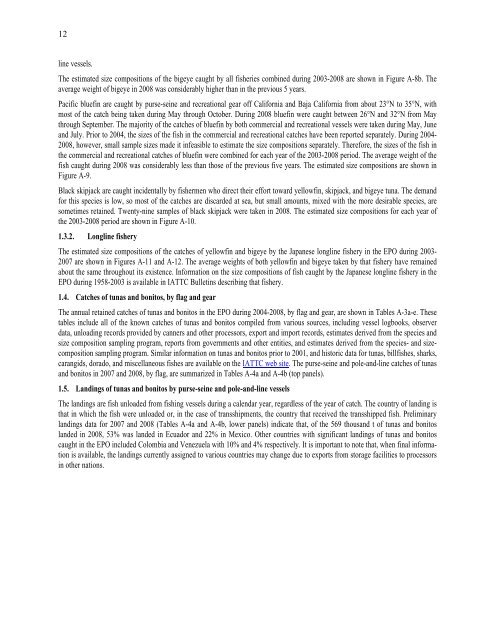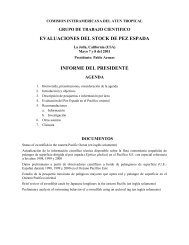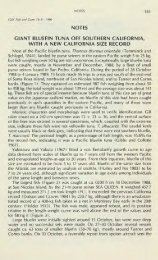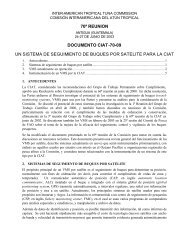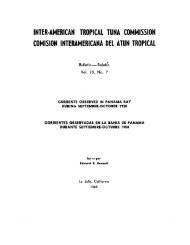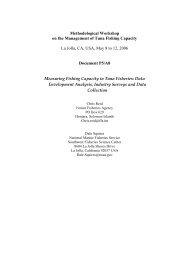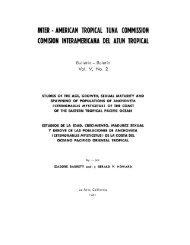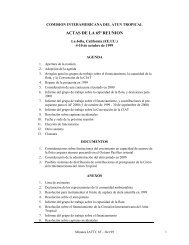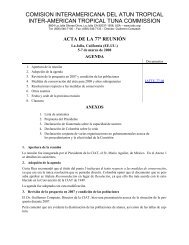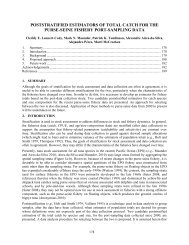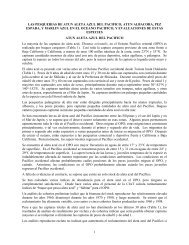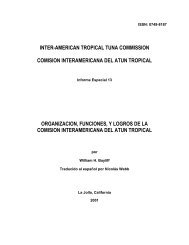INTER-AMERICAN TROPICAL TUNA COMMISSION - Comisión ...
INTER-AMERICAN TROPICAL TUNA COMMISSION - Comisión ...
INTER-AMERICAN TROPICAL TUNA COMMISSION - Comisión ...
- No tags were found...
You also want an ePaper? Increase the reach of your titles
YUMPU automatically turns print PDFs into web optimized ePapers that Google loves.
12line vessels.The estimated size compositions of the bigeye caught by all fisheries combined during 2003-2008 are shown in Figure A-8b. Theaverage weight of bigeye in 2008 was considerably higher than in the previous 5 years.Pacific bluefin are caught by purse-seine and recreational gear off California and Baja California from about 23°N to 35°N, withmost of the catch being taken during May through October. During 2008 bluefin were caught between 26°N and 32°N from Maythrough September. The majority of the catches of bluefin by both commercial and recreational vessels were taken during May, Juneand July. Prior to 2004, the sizes of the fish in the commercial and recreational catches have been reported separately. During 2004-2008, however, small sample sizes made it infeasible to estimate the size compositions separately. Therefore, the sizes of the fish inthe commercial and recreational catches of bluefin were combined for each year of the 2003-2008 period. The average weight of thefish caught during 2008 was considerably less than those of the previous five years. The estimated size compositions are shown inFigure A-9.Black skipjack are caught incidentally by fishermen who direct their effort toward yellowfin, skipjack, and bigeye tuna. The demandfor this species is low, so most of the catches are discarded at sea, but small amounts, mixed with the more desirable species, aresometimes retained. Twenty-nine samples of black skipjack were taken in 2008. The estimated size compositions for each year ofthe 2003-2008 period are shown in Figure A-10.1.3.2. Longline fisheryThe estimated size compositions of the catches of yellowfin and bigeye by the Japanese longline fishery in the EPO during 2003-2007 are shown in Figures A-11 and A-12. The average weights of both yellowfin and bigeye taken by that fishery have remainedabout the same throughout its existence. Information on the size compositions of fish caught by the Japanese longline fishery in theEPO during 1958-2003 is available in IATTC Bulletins describing that fishery.1.4. Catches of tunas and bonitos, by flag and gearThe annual retained catches of tunas and bonitos in the EPO during 2004-2008, by flag and gear, are shown in Tables A-3a-e. Thesetables include all of the known catches of tunas and bonitos compiled from various sources, including vessel logbooks, observerdata, unloading records provided by canners and other processors, export and import records, estimates derived from the species andsize composition sampling program, reports from governments and other entities, and estimates derived from the species- and sizecompositionsampling program. Similar information on tunas and bonitos prior to 2001, and historic data for tunas, billfishes, sharks,carangids, dorado, and miscellaneous fishes are available on the IATTC web site. The purse-seine and pole-and-line catches of tunasand bonitos in 2007 and 2008, by flag, are summarized in Tables A-4a and A-4b (top panels).1.5. Landings of tunas and bonitos by purse-seine and pole-and-line vesselsThe landings are fish unloaded from fishing vessels during a calendar year, regardless of the year of catch. The country of landing isthat in which the fish were unloaded or, in the case of transshipments, the country that received the transshipped fish. Preliminarylandings data for 2007 and 2008 (Tables A-4a and A-4b, lower panels) indicate that, of the 569 thousand t of tunas and bonitoslanded in 2008, 53% was landed in Ecuador and 22% in Mexico. Other countries with significant landings of tunas and bonitoscaught in the EPO included Colombia and Venezuela with 10% and 4% respectively. It is important to note that, when final informationis available, the landings currently assigned to various countries may change due to exports from storage facilities to processorsin other nations.


